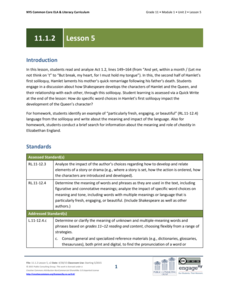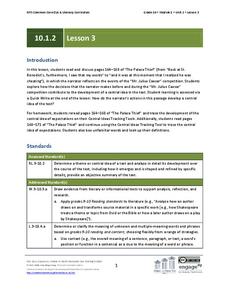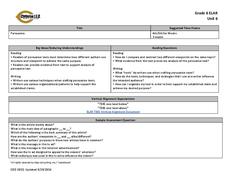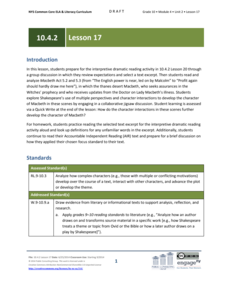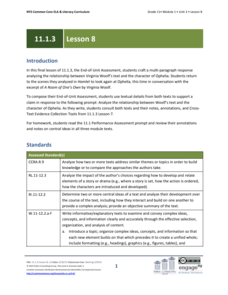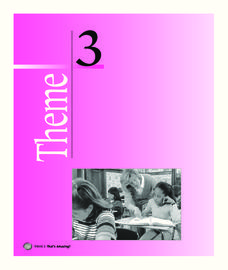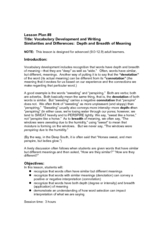EngageNY
Grade 10 ELA Module 4: Unit 2, Lesson 9
How does Shakespeare develop the central idea of agency versus fate in Macbeth? Using the resource, pupils work in small groups to discuss the plot of Act 3.1. Next, they complete a brief writing assignment to analyze how the main idea...
EngageNY
Grade 11 ELA Module 2: Unit 1, Lesson 7
Give the class some clarification. Scholars determine how Du Bois develops his central ideas in the chapter "Of Our Spiritual Strivings" by refining and clarifying his ideas. They organize their thoughts by annotating and recording the...
EngageNY
Grade 11 ELA Module 1: Unit 2, Lesson 5
Scholars delve into Act 1.2 of Shakespeare's Hamlet. By completing a writing exercise and participating in a class discussion, they continue to analyze how the author develops the characters in the play.
Curated OER
Children's Literature Across the Curriculum Ideas
You can keep this printable idea sheet and use when you're in a tight spot. It contains cross-curricular ideas that span every subject while relating to the African tale, "Anasazi the Spider." Learners will act, write, move, count, and...
EngageNY
Grade 10 ELA Module 4: Unit 1, Lesson 3
Are authors also designers? Scholars examine closely how E.B. White designs a section in Death of a Pig. They determine how the structure of sentences and paragraphs, the order of events, and the dialogue placement all contribute to the...
Curated OER
Reading Comprehension: Guinness Book of World Records
If your learners are curious about human achievement, superlatives, or esoteric trivia, the Guinness Book of Records is a way to tap into instrinsic motivation and relevance. Here's an informational reading that will grab their attention...
EngageNY
Grade 10 ELA Module 1: Unit 2, Lesson 3
Readers of "The Palace Thief" continue examining Ethan Canin’s short story and consider how the narrator's actions develop the central idea of how one's expectations and the expectations of others influence behavior.
EngageNY
Grade 10 ELA Module 1: Unit 2, Lesson 9
Do our childhood circumstances significantly shape us? As the close reading of “The Palace Thief” continues, groups examine how the results of the first "Mr. Julius Caesar" competition influenced the development of the characters in...
EngageNY
Grade 9 ELA Module 2, Unit 3, Lesson 2
"Everybody is guilty of something." As class members continue their close reading of Walter Mosley's essay, they examine how Mosley develops and supports his central ideas about Western civilization's relationship to guilt.
Cleburne Independent School District
Grade 6 English Language Arts and Readiness: Persuasive
What is the best way to compare and contrast viewpoints on the same topic? A persuasive writing unit plan addresses targeted skills, vocabulary, instructional strategies, and suggested resources that would be perfect for developing writers.
EngageNY
Grade 10 ELA Module 4: Unit 2, Lesson 17
Madness, violence, despair—the titular character of Shakespeare's Macbeth is spiraling out of control. Pupils first explore the topic with a collaborative jigsaw discussion. At the end of the instructional activity, they write about how...
EngageNY
Grade 11 ELA Module 1: Unit 3, Lesson 8
How does the theme of gender inequality develop in Virginia Woolf's A Room of One's Own and Shakespeare's Hamlet? Pupils craft a multi-paragraph response to analyze the relationship between the texts. They use evidence from both works to...
EngageNY
Grade 11 ELA Module 1: Unit 2, Lesson 4
How does a soliloquy differ from a monologue? Scholars read the first soliloquy from Shakespeare's Hamlet and compare it to Claudius's monologue. They also engage in a group discussion about Hamlet's character development.
Curated OER
Art: Drawing Ducks in Their Natural Habitats
Sixth graders explore various waterfowl species and discover how duck stamps are used. After researching specific types of birds for a stamp competition, they draw the birds in various natural settings. Before sending the submissions,...
Houghton Mifflin Harcourt
A World of Animals: English Language Development Lessons (Theme 10)
Animals are the theme of this series of English language development lessons. Scholars take part in grand conversations about woodland, jungle, and grassland animals. They also go on picture walks, read poems and high frequency words,...
Houghton Mifflin Harcourt
That’s Amazing!: English Language Development Lessons (Theme 3)
That's Amazing! is the theme of an English language development unit created by Houghton Mifflin. Following a speak, look, move, and listen routine, scholars delve into topics; seasons, weather, animals, landforms, telling time,...
Curated OER
Vocabulary Development and Writing
Engage pupils in practicing denotative and connotative strategies to understand particular words. They work in pairs and write a series of sentences using each word that has a positive connotation and negative connotation. Some example...
Curated OER
"The Possibility of Evil" Vocabulary
Read Shirley Jackson's "The Possibility of Evil" and complete this word study. You may choose to introduce these seven words before reading the text to front-load the new words. Words include indulgently, rapt, unchecked, degraded,...
Curated OER
"Desk Top Teaching" - Word Interrogation
Don't let your class get tripped up on the tricky words in Truman Capote's In Cold Blood! Instead, assign each member of the class one or two words and each can be an expert. Explicit directions are included, as well as a list of...
Curated OER
The Process of Art Criticism
Students interpret possible meanings of works of art by analyzing how specific works are created and how they relate to historical and cultural contexts
National Gallery of Canada
Reinventing the World
After examining and discussing Guy Ben-Ner's Treehouse Kit, a contemporary art installation with a sculptural and video element, small groups work together to create short silent films. The films should be built around a particular topic...
Curated OER
Shizuko’s Daughter: List-Group-Label Strategy
Help your learners navigate the vocabulary of Shizuko's Daughter by Kyoko Mori with a lesson on categorizing words. After coming up with a list of things that grow from the earth, learners decide which categories each words belong in.
Ogden Museum of Art Education Department
Literacy and Landscapes
As the saying goes, art often imitates life ... and literature! A series of activities designed to accompany a visit to the Ogden Museum of Southern Art encourage writers to find inspiration in various landscapes. The lesson includes a...
Santa Ana Unified School District
The Power of Point of View
Sometimes a whole story can change based on the perspective of the person telling it. Practice identifying and analyzing point of view in various reading passages and writing assignments with a language arts packet, complete with Common...




